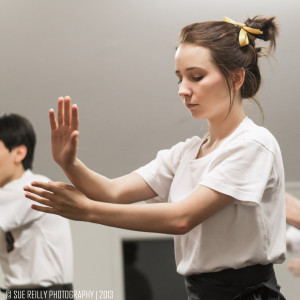Tai Ji Quan (Tai Chi)
Many people have been drawn to Tai Ji for its soothing health benefits. Indeed, relaxation and meditation are the foundations of Tai Ji. The graceful movements for which Tai Ji is famous are performed slowly and help foster relaxation in the practitioner. Tai Ji is a martial art for anyone. The early practitioners of Tai Ji eliminated strenuous physical movements so it could be practised even by the young, the sick and the elderly.

Through meditation, Tai Ji students learn to feel, harness and utilise the energy within their body; Qi. Western science sees Qi as relative to the ATP (Adenosine Triphosphate) in the body’s cells, which transports the chemical energy within cells for metabolism. It is closely linked to our respiratory, circulatory and nervous systems. In ancient China the Qi was believed to be an invisible, intangible force, separate from one’s will; the i (pronounced “ee”.) The Tai Ji stances and movements you will learn shall foster the circulation of Qi through your body. When the flow of Qi is impinged or stopped, people may feel it as an illness or physical discomfort. Smoothing the flow of Qi through a person’s body to enhance their well being follows the same principles as the ancient Chinese Medicine of Acupuncture. Through meditation and relaxation, you will learn to listen not to your ears or heart, but to your breath. Said Quang Tzu, an early figure influential in Tai Ji, “The ear is limited to ordinary hearing. The heart to the rational. But listening to the breath, one awaits things uncommittedly.”
![Yin/Yang symbol [Yin and Yang]](https://www.brisbanekungfu.com/images/yinyang.gif)
“Nothing under heaven is softer or more yielding than water; but when it attacks things hard and resistant there is not one of them that can prevail. For they can find no way of altering it. That the yielding conquers the hard is a fact known by all men, yet utilised by none”
Lao Tzu’s “Tao Te Ching (The Way of Power)”; an early Taoist writing.
Tai Ji however, is not just an effective system for health and relaxation, it is also a highly capable martial art. A person who is tense and tight is rigid and thus vulnerable to the blows of an attacker. But the training in relaxation and meditation allows a Tai Ji practitioner to be calm, relaxed and at peace, even in the midst of combat. Thus a Tai Ji practitioner can effortlessly evade and counter-attack their opponent. In the same way, a strong wind may topple a tall, mighty oak tree, yet leave a flimsy willow standing. In fact the bigger and stronger the opponent and the more force they attempt to use, the more easily they are overcome. Said Ch’en Wei-Ming, “With real T’ai-chi, your arm is like iron wrapped in cotton. It is very soft and light, yet feels heavy to someone trying to support it. When you touch your opponent, your hands are soft and light, but they cannot get rid of them. When your opponent is pushed ten feet away, they feel little movement but no strength. And no pain. But they cannot escape, and their own arms become sore. If they try and use force to control you, it is like catching the wind or shadows. Everywhere is empty… Real T’ai-chi is very wonderful.”
Classes
Your instructors are Shifu Richard Nicholls and Shifu Kevin The. ShiGong Jason King is also qualified as a Tai Ji Instructor and offers private tuition at his Springwood studio.
We hold a variety of classes throughout Brisbane in several locations each week. We cater for all paces and levels, from beginner to advanced. Please click here for our timetable. Your first lesson is free.
The History of Tai Ji
The true origins of Tai Ji are shrouded in time and will probably never be known with certainty. One story is that a stranger passing through the town of Ch’en-chia kou in the 16th century made negative comments about the townspeople’s own martial art. Yet when challenged to a duel, he defeated all comers with his own unique style. He was then asked to stay as a guest and teach his style to the townsfolk. This became Tai Ji Quan (commonly called just “Tai Ji.”) The town of Ch’en-Chia Kou has long been known as a centre of Tai Ji Quan.
Other stories are that a Taoist priest learnt it in a dream. Another is the priest conceived it after watching a snake and bird fight. He contrasted the soft, relaxed manner of their duel with that of the brute strength-on-strength combat of men. There are many other, less dramatic stories to choose from according too the excellent Comprehensive Asian Fighting Arts, by Draeger and Smith, 1980.
Tai Ji Grading Levels
LEVEL ONE
- 8 Tai Ji Stances
- 8 Tai Ji Circles
- 2 Qi Gong Stances
- 9 Qi Gong Warm Up Exercises
- Qi Gong Gong
LEVEL TWO
- 8 Tai Ji Gong
- 13 Form
- Qi Gong – Sinking Qi to Dan Tien
LEVEL THREE
- 24 Form Simplified Yang Style
- 4 Stationary Push Hands
- Tai Ji Staff Form
- Qi Gong – Strengthening Qi in Dan Tien
LEVEL FOUR
- 42 Competition Form (predominantly Yang)
- 8 Moving Push Hands
- Staff Applications
- Qi Gong – Circulating Qi through the microcosmic circuit.
LEVEL FIVE
- 9 Throw Down Applications
- Ba Gua Tai Ji Form
- Qi Gong – Combining Qi
LEVEL SIX
- Ba Gua Tai Ji Dao Form
- Tai Ji Wrestling
- 12 Fighting Actions
- Qi Gong – Applying Qi To Chinese Martial Arts
LEVEL SEVEN
- Ba Gua Tai Ji Jian Form
- Broadsword Applications
- Tai Ji Sparring
- Qi Gong – Applying Qi With Zen Principles
